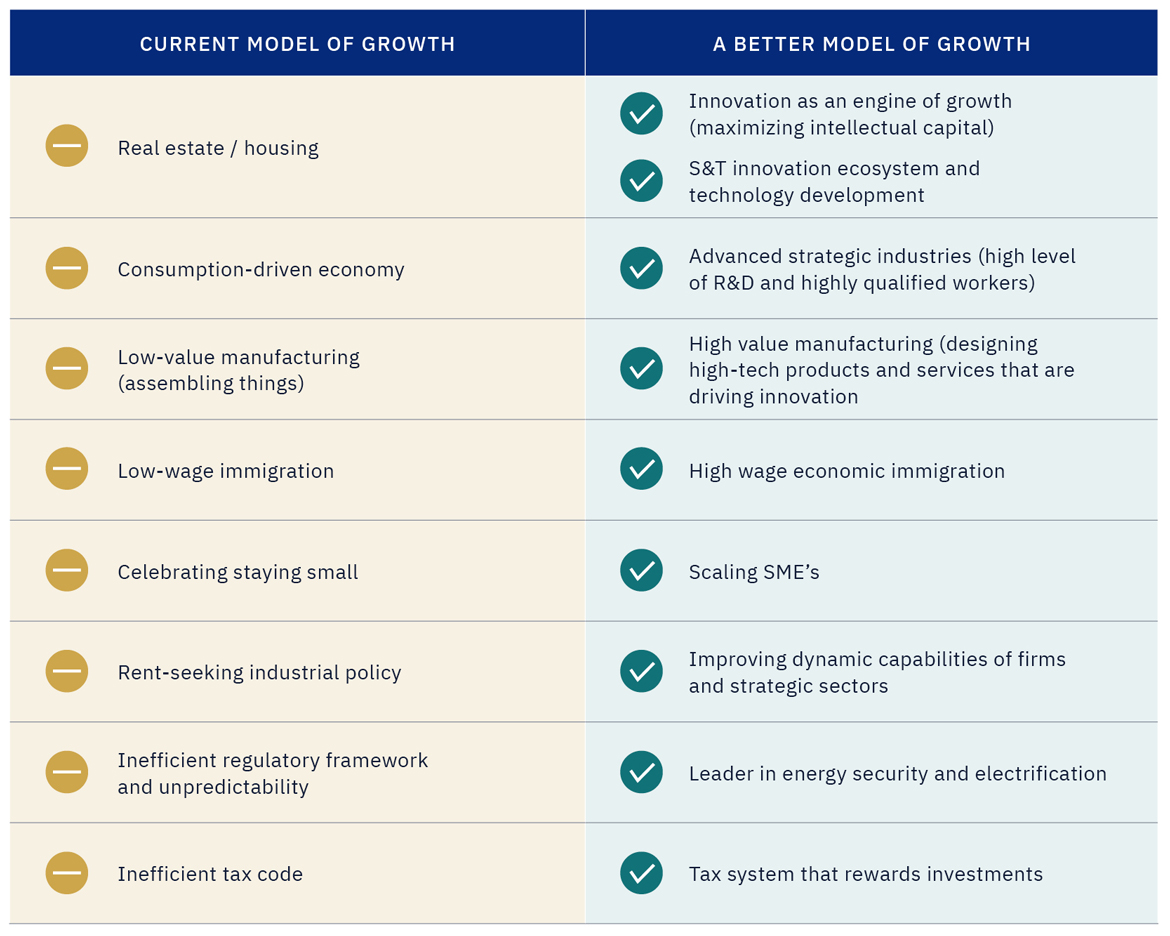The following is an excerpt from a report, “Engines of Growth” authored by Robert Asselin, senior vice-president policy at the Business Council of Canada and a former advisor to two prime ministers.
Canada has consistently ranked among the world’s top countries for its high quality of life. Abundant resources, a highly educated population, and strong international ties have all contributed to Canada’s enviable living standards.
However, progress has stalled.
Data from various sources, including Statistics Canada, the OECD, and other economic research institutions, reveal that Canada has experienced a period of economic growth lethargy over the past 15 years.
Canadians will not be able to sustain their living standards—including benefitting from cherished social programs—if the country doesn’t change course.
Progress is a policy choice, and policymakers have the agency to ensure Canadians’ living standards and wages do not stagnate or, worse, deteriorate. It is urgent that policymakers develop the conditions for building a forward-looking society, one that leverages innovation to drive economic prosperity.
As Bank of Canada Senior Deputy Governor Carolyn Rogers highlighted in a March 2024 speech:
Improving productivity in Canada needs to be a priority for everyone, and there are two basic strategies for doing it. One is to have the economy focus more on the industries that add greater value than less productive activities. The other strategy is to keep doing the jobs we’re doing but do them more efficiently. Ideally, Canada would use both strategies, leading to an economy with strong productivity growth and a large concentration of high-value industries.
Canada’s standard of living is determined by its economy-wide productivity. It must increase across the board, but especially in the high-value proportion of the economy.
The consequences of deindustrialization
The deindustrialization of many parts of Canada has had important implications. Many parts of Canada—most notably in Ontario—have traditionally bolstered the economy through the manufacturing sector. But as a recent report by RBC Economics illustrates, the impact of manufacturing is half what it was to the economy in 2000, while mining has also shrunk. The problem is as manufacturing has shrunk, it has not been replaced by high-value industries. In addition, investment levels in the oil and gas sector remain far below what they were a decade ago.
If industrial or sectoral composition is worrisome, so is scale.
Canada has essentially become a real estate and consumption economy. Ninety-eight percent of Canadian companies are small- and medium-sized enterprises (SMEs), which explains in part why business investments are so structurally weak. To a certain degree, this is true for many advanced economies. Two interrelated issues are at the heart of the problem:
- Canada has too few large companies (which are disproportionally more likely to spend on R&D and innovation), and
- Too few SMEs are scaling up.
These problems are related because it’s the most efficient and most productive companies that scale. Unproductive SMEs are unlikely to grow.
Meanwhile, investment in residential structures accounts for twice the share of GDP in Canada compared to the U.S. Businesses in Canada invest more in non-residential structures and less in intellectual property (IP) products. Canada invests about forty percent less (as a share of GDP) in intellectual property products overall.
An economy the size of Canada that produces a small share of goods and services that can be exported into global markets will have a difficult time becoming more productive.
If policymakers truly want to advocate for workers, they must ask the question: why has income growth stalled to rates rarely seen in Canada outside major recessions?
The answer is clear: there is a direct correlation between productivity and earnings.
From 1945 to 1975, the real average weekly wage in Canada doubled. This was largely achieved through improved productivity. At the current rate, it would take about four centuries to achieve this feat.
Wage growth has largely decelerated due to a slowdown in labour productivity. After adjusting for inflation, the average weekly earnings have increased only 1.6 percent between January 2015 and January 2024, or less than 0.2 percent per year. It’s a considerable change from a growth rate of more than 1.5 percent per year that Canadian workers enjoyed over the previous two decades.
Canada runs trade surpluses in agriculture, timber, minerals, and oil and gas. But it performs poorly in technologically advanced industries. This is where advanced economies compete and innovate. It is also where productivity gains can advance rapidly and where wages are higher.

Governor of the Bank of Canada Tiff Macklem and Senior Deputy Governor Carolyn Rogers participate in a news conference on the bank’s interest rate announcement, in Ottawa, Sept. 4, 2024. Justin Tang/The Canadian Press.
Advanced industries are sectors characterized by significant investment in R&D, high levels of technology integration, and a skilled workforce. They typically include industries such as energy, aerospace, biotechnology, information technology, advanced manufacturing, and robotics, which drive innovation and economic growth through cutting-edge technologies and processes.
Competing in advanced industries—such as biotechnology, aerospace, energy and clean tech, and advanced manufacturing—is crucial for modern economies. These industries drive innovation and productivity, leading to economic growth and high-wage job creation. They ensure global competitiveness by capturing significant market shares and attracting foreign direct investment. Additionally, they enhance national security by maintaining strategic autonomy and resilience.
Canada’s poor economic performance cannot be blamed on globalization. Rather, it is largely the result of an innovation deficit.
Canada has considerable assets that are not being leveraged in this age of heightened competition: it has the human capital and the natural resources that can fuel innovation and economic growth.
Not competing at scale in advanced industries means Canada will remain a low-innovation economy and, as a result, continue to slip on the global competitiveness scale. To succeed, the country must focus on innovation in industries where it has a comparative advantage, such as energy, agriculture, infrastructure, and biotechnology.
Maximizing our economic potential
Canada can be rightly proud of its global champions in advanced industries, but there simply aren’t enough of them to maximize the country’s economic potential. And there are no signs that could change anytime soon.
The economy is too reliant on consumption and suffers from a lack of investments that makes it much less productive than it should be.
The current policy approach favours rent-seeking and low-value manufacturing sectors. Rent-seeking industrial policy stifles productivity and competitiveness by encouraging businesses to seek government hand-outs instead of focusing on innovation. In industries like the automotive sector, the federal government has provided substantial subsidies to foreign companies, often preferencing assembly plants over domestic technology design and development. This approach to industrial policy, primarily through subsidies, not only often invests in rent-seeking industries but also inadvertently attracts more rent seekers.
Countries that succeed in enhancing their economic performance typically do so by concentrating on sectoral strengths—for example, electronics in South Korea, advanced manufacturing in Germany, financial services and biotechnology in Singapore, cybersecurity in Israel, and pharmaceuticals in Switzerland.
In contrast, Canada’s industrial policy is unfocused and ineffective, indiscriminately subsidizing companies across various sectors and regions without a clear, targeted strategy. This lack of focus has consequently limited productivity.
Rather than continuing with a patchwork approach to innovation policy, Canada must change course, embracing a long-term plan that capitalizes on the country’s considerable strengths.

Graphic credit: Janice Nelson.
A more effective policy would adopt a modern science and technology architecture, designed to commercialize the best ideas while nurturing talent and funding both fundamental and applied research.
Such a policy would champion sectors where Canada can have the greatest potential, such as energy and energy technology, ag-tech, advanced infrastructure, and biotechnology.
It would also capitalize on the historical advantages of a high-skilled immigration system. Right now, by overemphasizing immediate labour market demands and low-wage occupations, Canada risks undermining the long-term benefits of attracting highly skilled talent.
Economic growth is also being hindered by an overly complex and inefficient regulatory framework which creates considerable unpredictability, and internal trade barriers that stifle investments and capital.
The country is losing ground in tax competitiveness due to increasing taxes on corporations and individuals, which deters long-term productive investments.
Canada needs a better model of growth.






